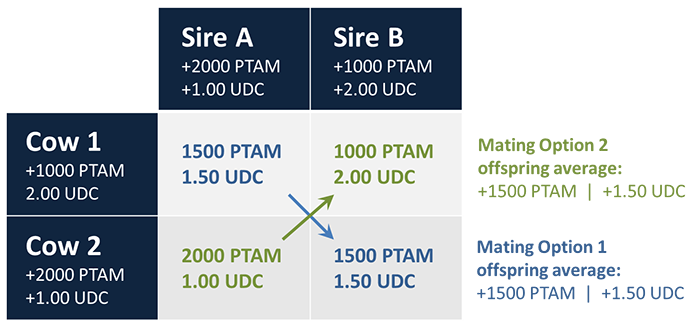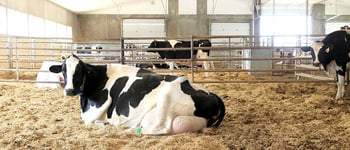“What is the true value of a mating program?”
Many producers around the world have used a mating program within their herd for many years. However, not all producers have put that keen focus on SIRE SELECTION. If you are in that same boat, you may be missing out on the best genetics to drive profitability on your farm.
Selection vs. mating – which is more important?
Before answering this question, it is important to realize what both of these terms mean.
SELECTION – The process of documenting genetic goals to determine which bulls will help you achieve those goals the fastest. In other words, it is identifying which bulls from the available population will be utilized in your herd.
MATING – The process of choosing which individual bull (of those selected for use in your herd) should be used on each individual cow.
Mating programs generally correct problematic type traits of a cow by using a bull whose trait strengths match a cow’s weaknesses. The goal of mating is to breed a consistent herd of cows. There is great merit in consistency, but it’s easy to see that when the right sires are not SELECTED, then MATING has little impact. If you desire to improve the udders in your herd, and only select sires with poor Udder Composite (UDC), you will not improve udders, regardless of whether your cows are mated or not.
Another frequently overlooked point is that even when you SELECT the right bulls, mating also has little impact! For example, if you select only the best UDC sires for your herd, the effect of individual matings will be minimized. Even if there was no mating program in place, you would still be improving udders in your herd simply by using those udder-improving sires.
Are you sacrificing genetic progress?
The value of a mating program is questioned by many dairy farmers. One in particular, who we’ll call Joe, wants to improve the production and health of his herd. With a nice, consistent group of cows, he has determined that the conformation of his herd is already more than adequate. (This is a common thought. You too can test this in your herd by asking yourself or your herdsman how many cows have been culled for conformation reasons in the past month or past year.) For many years, Joe has had his cows mated, but never put much thought into selection.
In Joe’s case, the mating program was run by allowing any bulls from the available lineup who were at least +500 PTAM and >1.0 UDC to be individually mated to each cow. This process meant semen from at least 20 different sires always remained in the tank. Although the topic of this article is not to discuss how many sires should be used at a given time, clearly having that many bulls increases the likelihood of recording errors and reduces efficiency for the breeders.
So, will Joe make more genetic progress for production and health by continuing his current method of mating without selection? Or would he be better off selecting a group of 5-8 bulls that meet his production & health goals, and randomly using those sires within his herd? Hopefully the answer is becoming clear.
Proof in examples
To break it down in the simplest form, if you want to use two different sires on two different cows, you have two options. The first option, shown below in blue, is to mate Cow 1 to Sire A, and Cow 2 to Sire B. The second option, shown in green, is to mate Cow 1 to Sire B and Cow 2 to Sire A.

Within the table, you can see the resulting offspring’s parent average figures for PTAM and UDC. As you can see, the offspring genetic average for PTAM and UDC are exactly the same, regardless of which cow is mated to which bull. Mating option 1 will give more consistency between daughters, but mating option 2 yields exactly the same genetic average between offspring.
So once you select certain bulls, the average genetic progress of your herd will be the same in the next generation whether the group of bulls are mated to individual cows, or if one bull is randomly selected for use each day of the week.
In one more example, let’s say Joe does an experiment on his farm. He randomly selects half of his herd to breed to Group A sires, and the other half of the herd to Group B sires. Just for the fun of it, we will say that the Group B sires are mated with a traditional program, and the Group A sires are randomly selected, with one bull being used each day of the week.
Group A: 5 sires that average +100 CFP and +4.0 PL
Group B: 5 sires that average +30 CFP and 0.0 PL
The offspring from Group A sires will average 70 lbs more CFP and four extra productive months in the herd than daughters of Group B sires – even though Group A was randomly bred with no mating program. If both groups were individually mated, the difference between the offspring of each group would still be exactly the same. Daughters of Group A sires will still yield 70 lbs more CFP and four more productive months in the herd than daughters of Group B sires!
What is the value in mating programs?
The quick answer from a purely genetic standpoint is that the value in mating is minimal at best. But there are a couple benefits.
First of all, the mating staff is often the same staff with whom you set your genetic goals. Having people you trust help you design and build your genetic program is extremely important.
The second value of a mating program comes through inbreeding protection. We do not want daughters of a given bull to be bred to their brother, uncle, nephew, or worse yet their father himself! Mating programs do a good job of reducing inbreeding within your herd. However, in order to maximize this value from a mating program you must have two things in good order on your dairy:
- Your Identification must be accurate – not knowing the real sire of a cow, makes inbreeding protection impossible.
- The technicians must closely follow the mating recommendations. There are way too many herds that go through the process of mating the cows, but very few of those mates are actually followed.
This article is not written to discourage anyone from mating. Mating can help create a consistent group of cows. And for those interested in breeding a “great” cow, protecting faults is important.
However, if inbreeding prevention is the reason for mating, you must ask yourself if it is still necessary to have someone look at cows to mate them. Both a pen mating, which tells which bulls should be avoided on an individual animal, or pen of animals, and a pedigree mating are effective options to minimize inbreeding.
Drive genetic progress – put a plan in place
There are two important concepts to remember when setting genetic goals, and selecting bulls that fit those goals.
- We cannot mate our way out of a bad selection decision
- When you select the proper bulls to fit your genetic plan, you will maximize genetic progress, even with no individual matings. However it is good practice to utilize a pedigree or pen mating to ensure inbreeding is managed.
The most important concept to remember is that genetic progress is driven by the goals you set and the bulls you use on your dairy – not the individual cows to which those bulls are mated.
So in order to maximize genetic progress and profitability on your farm, be sure to spend at least as much time setting your genetic goals and defining your selection program as you do on your mating program.


